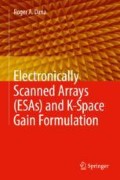Abstract
The often used but rarely justified formula by Blake that the antenna temperature T A contribution from sky temperature T S is T A = 0.876T S+36°K. This equation is particularly mysterious when one considers the origin of the coefficients 0.876 and 36°K. In this chapter, the basic principles behind this expression are discussed, and it is shown to be valid for a 1950s type of antenna with high back or sidelobes. A general expression that applies to modern ESAs is developed.
This Section was originally presented as a paper (Dana 2016).
Access this chapter
Tax calculation will be finalised at checkout
Purchases are for personal use only
Notes
- 1.
Purists might use spatially homogeneous rather than spatially stationary to describe the idea that the statistics of sky temperature are assumed to be independent of position.
- 2.
Solar luminosity at RF is −153 dBm/Hz and its angular width is about 0.5°. So an antenna with this beamwidth can provide a 21 dB increase in the noise floor to the receiver (or, as your mother said, don’t look at the solar). For larger beamwidths, the antenna “sees the solar” in its average sidelobes, and its effect is included in the sky temperature.
- 3.
Precisely why Blake writes this expression with a leading coefficient of 0.876 is not clear, but if one believes that the sky temperature contribution to antenna temperature is accurate to three decimal places, then one has bigger issues than just this discrepancy.
References
Blake, L. V. (1969a, December). A guide to basic pulse-radar maximum-range calculation, part 1: Equations, definitions, and aids to calculation, NRL-R-6930.
Blake, L. V. (1969b, December). A guide to basic pulse-radar maximum-range calculation, part 2: Derivations of equations, bases of graphs, and additional explanations, NRL-R-7010.
Dana, R. A. (2016, September). Revisit of antenna sky temperature for ESAs. In: Proceedings of antenna applications symposium.
Taylor, T. T. (1955, January). Design of line source antenna for narrow beam width and low side lobes. IRE Transactions on Antennas and Propagation, 3, 16–28.
Author information
Authors and Affiliations
Rights and permissions
Copyright information
© 2019 Springer Nature Switzerland AG
About this chapter
Cite this chapter
Dana, R.A. (2019). Effect of Sky Noise on Antenna Temperature. In: Electronically Scanned Arrays (ESAs) and K-Space Gain Formulation. Springer, Cham. https://doi.org/10.1007/978-3-030-04678-1_4
Download citation
DOI: https://doi.org/10.1007/978-3-030-04678-1_4
Published:
Publisher Name: Springer, Cham
Print ISBN: 978-3-030-04677-4
Online ISBN: 978-3-030-04678-1
eBook Packages: EngineeringEngineering (R0)

